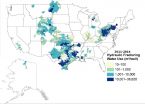Spouses & relatives of celiac disease patients at risk for autoimmune diseases
2015-06-30
(Press-News.org) Bethesda, MD (June 30, 2015) -- Both spouses and first-degree relatives of patients with celiac disease are at increased risk of nonceliac autoimmune disease, according to a study in the July issue of Clinical Gastroenterology and Hepatology, the official clinical practice journal of the American Gastroenterological Association. This risk represents a mixture of genetic, environmental and ascertainment bias mechanisms.
"The prevalence of celiac disease in first-degree relatives of individuals with celiac is approximately 10 percent. Despite these findings, little is known about the risk of nonceliac autoimmune disease in these individuals," said lead study author Louise Emilsson, MD, PhD, from Oslo University and Primary care research unit, Värmlands Nysäter. "We found convincing results that close relatives are also at risk for these conditions, but more surprisingly, we found that spouses may also be at risk."
Researchers conducted a nationwide, population-based long-term observational cohort study using the Swedish Multi-Generation Register to monitor the risk of nonceliac autoimmune disease, which includes Crohn's disease, type 1 diabetes mellitus, hypothyroidism, hyperthyroidism, psoriasis, rheumatoid arthritis, sarcoidosis, systemic lupus erythematosus and ulcerative colitis. The analysis included more than 84,000 first-degree relatives (fathers, mothers, siblings and offspring) and spouses of patients with celiac disease, and 430,942 controls.
During the follow-up period, which averaged close to 10.8 years, 4.3 percent of celiac relatives developed nonceliac autoimmune disease, compared to 3.3 percent in the control group. Systemic lupus erythematosus, type I diabetes mellitus and sarcoidosis were the most common nonceliac autoimmune diseases seen in patients.
While the excess risk found in celiac first-degree relatives can be explained by genetics, the higher risk in spouses points to the impact of environmental factors. It is also possible that spouses share microbiome characteristics with their husband/wife, which might impact the risk of developing and diagnosing other autoimmune diseases.
Another explanation is ascertainment bias, meaning that first-degree relatives and spouses are likely to seek medical advice or undergo celiac disease testing more often than the general population. It could also mean that doctors who are aware of the celiac disease patient are more likely to investigate first-degree relatives and spouses for autoimmunity.
INFORMATION:
Celiac disease, which affects approximately 1 percent of the Western population, is an autoimmune disorder that causes your immune system to interfere with the proper function of the small intestine. Learn more about celiac disease in the AGA patient brochure.
This study was funded by the Swedish Research Council.
1 Emilsson, Louise, et al. Autoimmune Disease in First-Degree Relatives and Spouses of Individuals With Celiac Disease, Clinical Gastroenterology and Hepatology, Volume 13(7): 1271-1277.e2. http://www.cghjournal.org/article/S1542-3565(15)00112-3/abstract
About the AGA Institute
The American Gastroenterological Association is the trusted voice of the GI community. Founded in 1897, the AGA has grown to include more than 16,000 members from around the globe who are involved in all aspects of the science, practice and advancement of gastroenterology. The AGA Institute administers the practice, research and educational programs of the organization. http://www.gastro.org.
About Clinical Gastroenterology and Hepatology
The mission of Clinical Gastroenterology and Hepatology is to provide readers with a broad spectrum of themes in clinical gastroenterology and hepatology. This monthly peer-reviewed journal includes original articles as well as scholarly reviews, with the goal that all articles published will be immediately relevant to the practice of gastroenterology and hepatology. For more information, visit http://www.cghjournal.org.
Like AGA and Clinical Gastroenterology and Hepatology on Facebook.
Join AGA on LinkedIn.
Follow us on Twitter @AmerGastroAssn.
Check out our videos on YouTube.
ELSE PRESS RELEASES FROM THIS DATE:
2015-06-30
Bethesda, MD (June 30, 2015) -- Pinaverium offers quick and effective relief of irritable bowel syndrome (IBS) symptoms, according to clinical trial results published in Clinical Gastroenterology and Hepatology, the official clinical practice journal of the American Gastroenterological Association.
Pinaverium bromide (pinaverium), an antispasmodic, is used widely in many countries around the world, including European countries, Canada and Mexico. However, original clinical studies on pinaverium are scarce and there has been no convincing evidence for its effectiveness ...
2015-06-30
Although vitamin A supplementation can have profound health benefits when someone is deficient, new evidence is emerging to show that vitamin A supplementation above and beyond normal levels may have negative health consequences. A new research report published in the July 2015 issue of the Journal of Leukocyte Biology may help to explain why too much vitamin A can be harmful. Too much vitamin A shuts down the body's trained immunity, opening the door to infections to which we would otherwise be immune. This study adds to the arguments that vitamin A supplementation should ...
2015-06-30
WASHINGTON, D.C. - The amount of water required to hydraulically fracture oil and gas wells varies widely across the country, according to the first national-scale analysis and map of hydraulic fracturing water usage detailed in a new study accepted for publication in Water Resources Research, a journal of the American Geophysical Union. The research found that water volumes for hydraulic fracturing averaged within watersheds across the United States range from as little as roughly 9,800 liters (2,600 gallons) to as much as 37 million liters (9.7 million gallons) per well.
In ...
2015-06-30
A new report published in the July 2015 issue of The FASEB Journal suggests that a common molecule found in higher animals, including humans, affects brain structure. This molecule may play a significant role in how brain cells communicate, possibly shedding light on the underlying causes of certain brain disorders. The study, involving mice, shows that small changes in how sialic acid attaches to cell surfaces result in damaging effects on brain structure, poor motor skills, hyperactivity, and difficulty in learning.
"Sialic acid is part of the molecular language that ...
2015-06-30
It is well known that muscles need resistance (gravity) to maintain optimal health, and when they do not have this resistance, they deteriorate. A new report published in the July 2015 issue of The FASEB Journal, however, suggests that this might not be true for all muscles, offering hope that there may be ways to preserve muscle mass and strength for individuals in low-resistance environments, whether it be the microgravity of space, extended periods in a hospital bed, or a 9-5 job behind a desk.
"Maintaining muscle mass and good muscle repair is key to all areas of ...
2015-06-30
Here's more evidence that fish oil supplementation and antioxidants might be beneficial for at least some people facing Alzheimer's disease: A new report published in the July 2015 issue of The FASEB Journal describes the findings of a very small study in which people with mild clinical impairment, such as those in the very early stages of the disease, saw clearance of the hallmark amyloid-beta protein and reduced inflammation in neurological tissues. Although the findings involved just 12 patients over the course of 4 to 17 months, the findings suggest further clinical ...
2015-06-30
WASHINGTON - Cardiac arrest strikes almost 600,000 people each year, killing the vast majority of those individuals, says a new report from the Institute of Medicine. Every year in the U.S., approximately 395,000 cases of cardiac arrest occur outside of a hospital setting, in which less than 6 percent survive. Approximately 200,000 cardiac arrests occur each year in hospitals, and 24 percent of those patients survive. Estimates suggest that cardiac arrest is the third leading cause of death in the U.S. behind cancer and heart disease.
Following a cardiac arrest, each ...
2015-06-30
WASHINGTON, DC --June 30, 2015--Human urine contains factors that prevent a common culprit in urinary tract infections (UTIs), uropathogenic Escherichia coli bacteria, from properly attaching to bladder cells, a necessary step for infection. The research, published this week in mBio, the online open-access journal of the American Society for Microbiology, reveals a weakness that could be exploited to develop more effective, non-antibiotic treatments for UTIs.
"There is a pressing, unmet need when it comes to developing new and better ways to treat UTIs," says Scott Hultgren, ...
2015-06-30
WASHINGTON, June 30 -- Hantaviruses use cholesterol in cell walls to gain access into cells and infect humans, according to laboratory research published this week in mBio®, the online open-access journal of the American Society for Microbiology.
"Our work demonstrates that hantaviruses are extremely sensitive to the amount of cholesterol in the membranes of the cells they are trying to infect," said senior study author Kartik Chandran, Ph.D., an associate professor of microbiology and immunology, and Harold and Muriel Block Faculty Scholar in Virology, at the Albert ...
2015-06-30
From our nation's founding, the Fourth of July has been synonymous with fireworks.
While many grew up learning that fireworks can be dangerous to the eyes and hands if not handled properly, fireworks also produce air pollutants, including particulate matter, that are linked to short-term or long-term health effects.
NOAA scientist Dian Seidel and Abigail Birnbaum, a student intern at NOAA, have authored a new study appearing in the journal Atmospheric Environment that quantifies the surge in fine particulate matter -particles that are two and one half microns in diameter ...
LAST 30 PRESS RELEASES:
[Press-News.org] Spouses & relatives of celiac disease patients at risk for autoimmune diseases

